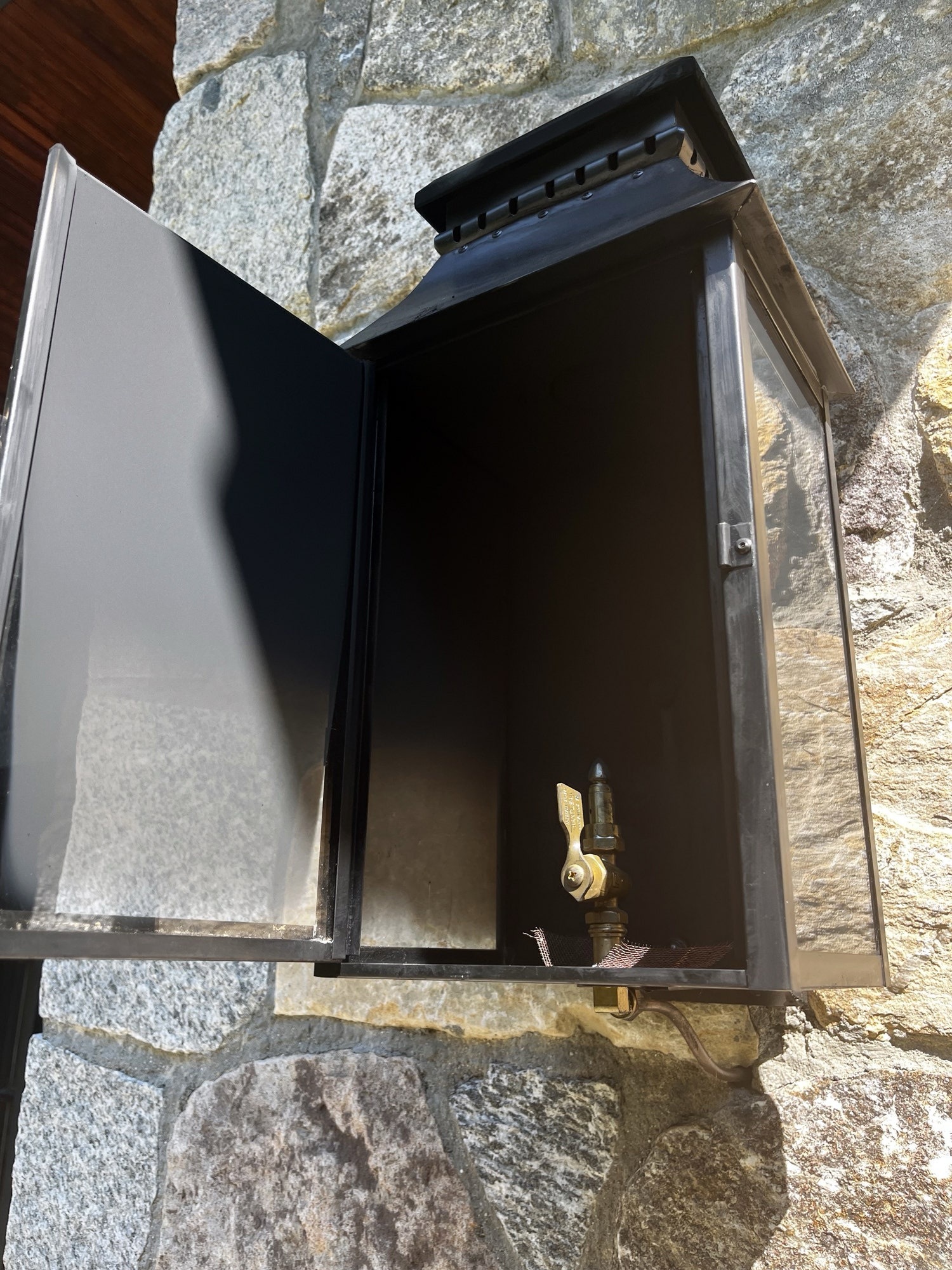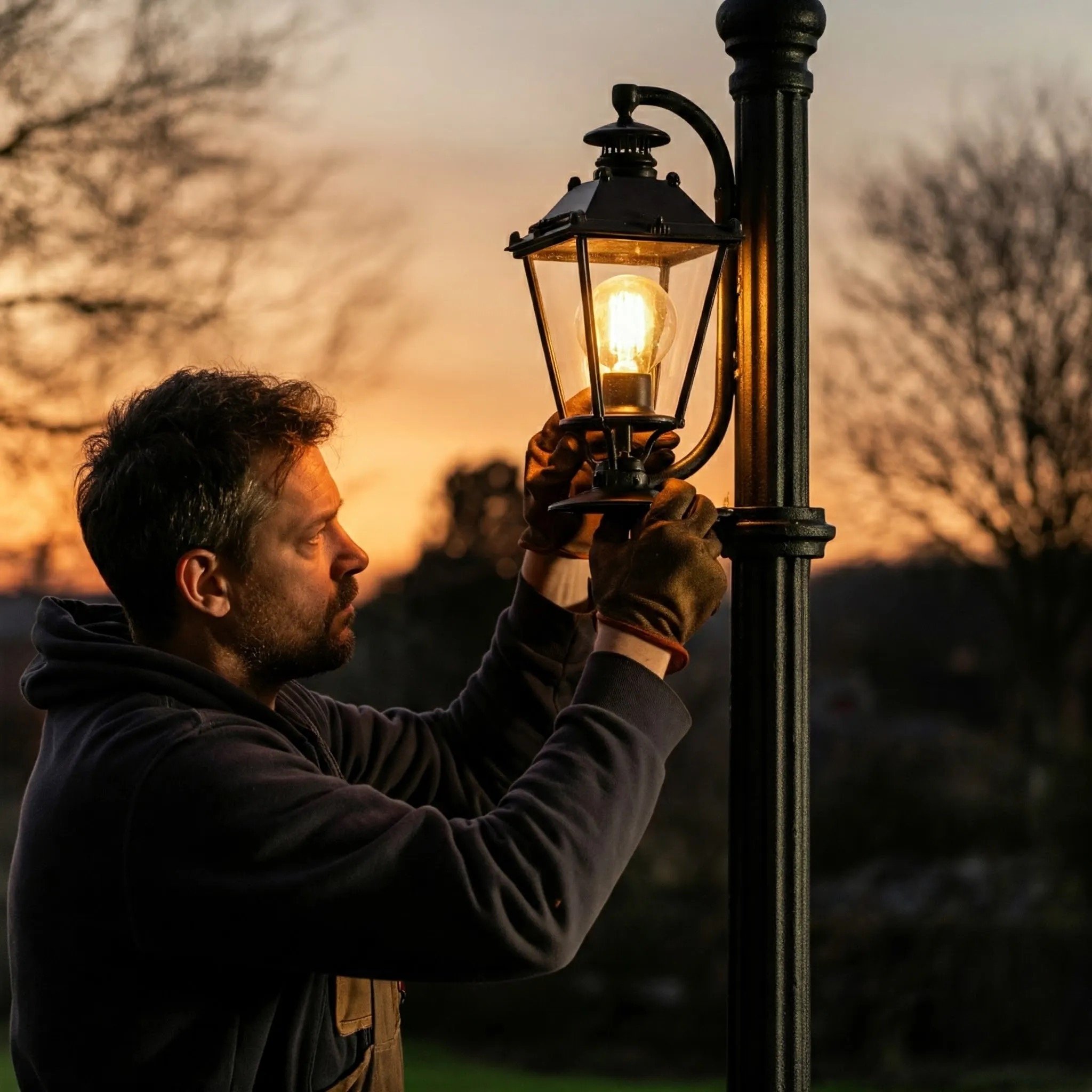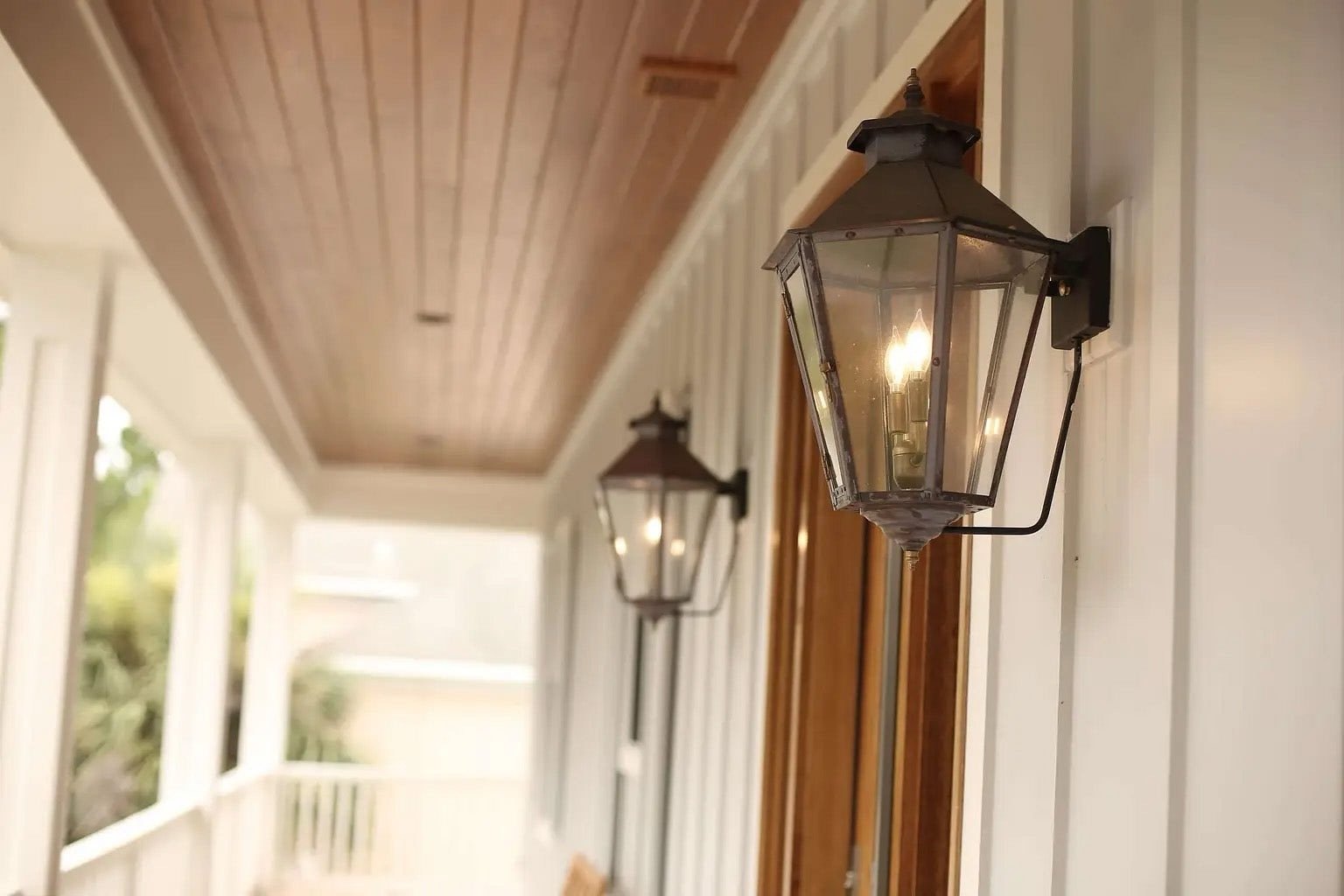The glow of a lantern on a home’s façade is more than just illumination; it is a statement of style, a beacon of welcome, and the final architectural detail that transforms a house into a home. For centuries, the soft flicker of an open flame has defined the ambiance of historic streets and stately entrances. Today, while that timeless allure remains, modern technology presents a compelling alternative. This brings homeowners and designers to a critical decision: should you embrace the classic, romantic soul of a gas lantern or the versatile, modern convenience of an electric one?
This is not a simple choice of hardware, but a choice about the character and atmosphere of your home. It involves weighing aesthetics against practicality, long-term costs against upfront investment, and tradition against innovation.
At French Market Lanterns, we believe an informed decision is the foundation of timeless design. We have guided thousands of clients through this process, and our expertise is built on a deep understanding of both technologies. This guide is designed to give you that same clarity. We will move beyond surface-level comparisons to provide a comprehensive, expert analysis of every factor, empowering you to choose the perfect lighting to elevate your home's story.
1. Aesthetics & Ambiance: The Soul of the Light
The most profound difference between gas and electric lanterns lies in the quality of the light itself. This is a sensory and emotional distinction that will define your home's presence every single evening.
The Living Flame of Gas Lanterns
A gas lantern does not simply contain a light; it contains a fire. The flame is alive, dancing and flickering with a gentle, random motion that is impossible to perfectly replicate. This creates an atmosphere of unparalleled romance and historic authenticity.
- The Signature Flicker: The soft, continuous movement of a gas flame is mesmerizing. It casts dynamic shadows that play across architectural surfaces, bringing stone, brick, and wood to life. This organic quality, often described as chiaroscuro, is what gives gas lighting its deep, soulful character. It feels warm, natural, and intrinsically welcoming.
- Color Temperature & Glow: A natural gas flame burns at a color temperature of approximately 1800 Kelvin. This is a deep, warm, amber-orange glow that is inherently calming and flattering. It evokes the nostalgia of candlelight and gaslit city streets, creating an ambiance that feels both luxurious and deeply comforting. It’s a light you feel as much as you see.
- Unbroken Presence: Gas lanterns are typically designed to run continuously, providing a constant beacon from dusk until dawn. This constant, gentle presence turns the lantern into a permanent architectural feature, not just a light that is switched on and off. It becomes a landmark for your home, always there to welcome you.
For the Designer & Homeowner: Choose gas when the primary goal is to create an emotional connection and a sense of timeless elegance. It is the definitive choice for historic properties, traditional architectural styles (like French Country, Colonial, or Tudor), and any home seeking to cultivate an atmosphere of romantic, old-world charm. It’s an investment in ambiance.
The Controlled Brilliance of Electric Lanterns
Where gas offers a single, perfect note of warm ambiance, electric lanterns offer a full orchestra of possibilities. Modern electric lighting provides unparalleled control, versatility, and adaptability, making it a powerful tool for the modern designer and homeowner.
- Precision and Consistency: An electric lantern provides steady, unwavering light. This consistency is ideal for spaces where clear, reliable visibility is the top priority, such as main entryways, walkways, and garage areas. The light is predictable and uniform, ensuring safety and security.
- The Power of the Bulb: The true magic of electric lanterns lies in the choice of the bulb. You are no longer limited to a single look:
- LED Flame-Effect Bulbs: Modern technology has produced remarkable LED bulbs that simulate the flicker and warm color of a gas flame with surprising realism. While not a perfect match for a true flame, they offer a compelling, low-maintenance, and energy-efficient alternative for those who love the look but prefer electric systems.
- Smart Bulbs (e.g., Philips Hue): Integrate your lanterns into a smart home ecosystem. Change the color temperature from a warm, gas-like glow to a cool, modern white with a tap on your phone. Dim the lights to set a mood, program them to turn on and off with the sunset or sync them with security systems.
- Edison & Vintage-Style Bulbs: Achieve a popular vintage or industrial aesthetic with the intricate filaments of an Edison-style bulb, adding another layer of design detail to the fixture itself.
- On-Demand Functionality: Electric lanterns are connected to a switch, a timer, or a motion sensor. You have complete control over when they are on, allowing you to conserve energy and use the light only when needed.
For the Designer & Homeowner: Choose electric when control, versatility, and integration are paramount. It is the perfect solution for contemporary and transitional homes, or for homeowners who want to fine-tune their lighting to match different occasions. If you envision your lighting changing from a welcoming warm glow to a bright security light, electric provides that power.
2. Operating Costs & Long-Term Investment: A Data-Informed Analysis
A beautiful lantern is an investment in your home's value. Understanding the long-term operating costs is essential to making a wise financial decision. While upfront costs differ, the ongoing expenses for fuel and maintenance will have a significant impact over the lifetime of the fixture.
To analyze this, we must consider the fuel source (natural gas, propane, electricity) and the cost of replaceable components (bulbs).
Gas Lantern Operating Costs
Gas consumption is measured in British Thermal Units (BTUs). A typical open-flame gas lantern uses between 1,000 and 3,500 BTUs per hour, depending on the burner configuration. For this analysis, let's use an average of 2,500 BTUs/hour.
-
Natural Gas:
- Natural gas is sold in "therms" (1 therm = 100,000 BTUs).
- The national average cost is approximately $1.50 per therm. (This varies significantly by region).
- Calculation:
-
2,500 BTUs/hour * 12 hours/day = 30,000 BTUs per day
-
30,000 BTUs/day * 30 days/month = 900,000 BTUs per month
-
900,000 BTUs / 100,000 BTUs/therm = 9 therms per month
- Estimated Monthly Cost:
9 therms * $1.50/therm = $13.50 per month per lantern
-
-
Propane (LP Gas):
- Propane is sold in gallons (1 gallon ≈ 91,500 BTUs).
- The national average cost is approximately $3.00 per gallon. (This can fluctuate more than natural gas).
- Calculation:
-
900,000 BTUs per month / 91,500 BTUs/gallon ≈ 9.8 gallons per month
- Estimated Monthly Cost:
9.8 gallons * $3.00/gallon = $29.40 per month per lantern
-
Key Takeaway for Gas: Natural gas is a surprisingly affordable way to achieve the authentic flame aesthetic, often costing less than leaving a high-wattage incandescent bulb on. Propane is a more expensive but excellent alternative for homes without access to a natural gas line. There are no bulbs to replace, making the fuel the only significant ongoing cost.
Electric Lantern Operating Costs
Electric costs depend on the lantern's wattage and your local electricity rate. The average US electricity rate is about $0.17 per kilowatt-hour (kWh). The game-changer here is the light bulb technology.
Let's compare three common bulb types, assuming 12 hours of use per day (360 hours per month).
| Bulb Type | Wattage (Brightness Equivalent to Gas) | Monthly Energy Use (kWh) |
Estimated Monthly Cost (@ $0.17/kWh) |
Bulb Lifespan (Hours) | Estimated Annual Bulb Replacement Cost | Total Estimated Annual Cost |
|---|---|---|---|---|---|---|
| Incandescent | 60W | 21.6 kWh | $3.67 | 1,000 |
4.38 (4.4bulbs/yr@4.38 (4.4bulbs/yr@1/bulb) |
~$48.42 |
| Halogen | 43W | 15.5 kWh | $2.64 | 1,000 |
13.14 (4.4bulbs/yr@13.14(4.4bulbs/yr@3/bulb) |
~$44.82 |
| LED (Flame-Effect) | 5W | 1.8 kWh | $0.31 | 15,000 |
0.40 (1bulbevery3.4years@0.40(1bulbevery3.4years@5/bulb) |
~$4.12 |
Key Takeaway for Electric: Using modern LED bulbs makes the operating cost of electric lanterns almost negligible—often less than 50 cents per month. While older incandescent or halogen bulbs are less efficient, the primary advantage of electric is the ultra-low cost and low-maintenance longevity offered by LED technology.
Return on Investment (ROI) Framework
An ROI calculator would weigh these factors:
- Upfront Cost: Gas lantern installation (plumbing) is typically more expensive than standard electrical wiring.
- Operating Cost: As shown above, LED electric is the cheapest to run, followed by natural gas. Propane is the most expensive fuel.
- Maintenance Cost: Negligible for gas. For electric, it depends on bulb choice but is very low with LEDs.
- Intangible Value: This is the most important factor. What is the value of perfect ambiance? What is the value of reliability during a power outage? What is the value of smart-home control?
The Verdict on Cost: For the absolute lowest long-term operating cost, an electric lantern with an LED bulb is the undisputed winner. However, natural gas lanterns offer their priceless, authentic ambiance for a very reasonable monthly cost, often less than a couple of specialty coffees. The decision comes down to whether the ~$10-15 monthly premium for gas is a worthy investment for the unparalleled atmosphere it provides.
3. Installation & Maintenance: From Planning to Upkeep
The requirements for installing gas and electric lanterns are fundamentally different, each demanding specific professional expertise to ensure safety, performance, and longevity.
Gas Lantern Installation: A Plumber's Craft
Installing a gas lantern is a job for a licensed and experienced plumber or certified gasfitter. This is non-negotiable. The process involves running a dedicated, low-pressure gas line from your home's main supply to the lantern's location.
The Typical Installation Process:
- Planning the Route: The plumber will determine the safest and most efficient path for the gas line, which may run through a basement, crawlspace, or be trenched underground for post-mounted lanterns.
- Running the Line: A copper or iron pipe (depending on local codes) is installed. This is the most labor-intensive part of the process. For brick or stone facades, this requires precise drilling.
- Valve Installation: A shut-off valve is installed near the lantern for maintenance and safety, often concealed within the wall or mounting plate.
- Pressure Testing: Before the lantern is connected, the entire line is pressurized and tested for leaks over a period of time to ensure it is 100% sealed and safe. This is a critical step.
- Final Connection: The lantern is mounted and connected to the gas line. The plumber will then light the lantern, adjust the flame to the proper height, and check the thermocouple/auto-shutoff for correct operation (purchased separately).
Maintenance for Gas Lanterns: Gas lanterns are remarkably low-maintenance. The beauty of their simple design is their durability.
- Routine Cleaning (Quarterly): Simply wipe down the glass panels (inside and out) with glass cleaner and clean the copper body with a soft cloth. This preserves the clarity of the light and allows the copper's patina to develop gracefully.
- Annual Check-up: Once a year, it's wise to check the burner tip for any debris (like cobwebs or soot buildup) that could obstruct gas flow and affect the flame's shape. This can typically be cleared with a soft brush or compressed air.
Electric Lantern Installation: An Electrician's Domain
Installing an electric lantern requires a licensed electrician to ensure the work is safe and up to code. The complexity can vary dramatically based on the existing infrastructure.
The Typical Installation Process:
- Assess Existing Wiring: If you are replacing an existing electric fixture, the job can be very straightforward—often taking less than an hour. The electrician will simply disconnect the old fixture and connect the new one to the existing junction box.
- Running New Wiring: If there is no pre-existing fixture, the process is more involved. It requires running a new electrical cable from a power source (like an interior outlet or the main breaker panel) to the desired location.
- Box Installation: A weatherproof junction box must be installed on the exterior wall to house the wiring connections safely.
- Switch & Control: The line will be connected to an interior switch, a timer, or a smart-home control module.
- Final Connection: The lantern is mounted to the junction box, the wires are connected, and the fixture is sealed against the elements with caulk to prevent water intrusion.
Maintenance for Electric Lanterns: Maintenance is minimal and familiar to any homeowner.
- Bulb Replacement: This is the primary maintenance task. With long-lasting LEDs, you may only need to do this once every few years.
- Routine Cleaning: Same as gas lanterns—regular cleaning of the glass and body will keep it looking its best.
4. Safety & Reliability: Peace of Mind in All Conditions
Concerns about safety, especially regarding an open flame, are understandable. However, modern gas lanterns are engineered with multiple safety features and offer a level of reliability that electric lights cannot match.
The Safety of Modern Gas Lanterns
It's helpful to think of a gas lantern not as a primitive torch, but as a small, elegant version of other trusted gas appliances in your home, like your furnace, water heater, or cooktop. They operate on the same principles and are subject to stringent safety standards.
- Low-Pressure System: Outdoor gas lanterns operate on a very low-pressure system, typically just ¼ PSI (pounds per square inch). This is a gentle, controlled flow, not a high-pressure jet.
- Automatic Flame Shut-off (Thermocouple): This is the most critical safety feature. A thermocouple is a heat-sensitive probe that sits in the flame. If the flame is ever extinguished (e.g., by an extreme gust of wind), the thermocouple cools down instantly. This sends a signal to the gas valve, which automatically closes, stopping the flow of gas. This prevents any unlit gas from escaping.
- Professional Installation: The most important safety factor is ensuring the lantern is installed correctly by a qualified professional who pressure-tests the lines.
Reliability: The Unmatched Advantage of Gas
In an age of dependence on the electrical grid, the gas lantern offers true self-sufficiency.
The Ultimate Benefit: When a storm hits and the power goes out, your home will not be plunged into darkness. Your gas lanterns will continue to burn brightly, providing a reassuring and beautiful source of light and security.
This single feature is often the deciding factor for homeowners in areas prone to power outages. While neighbors are fumbling for flashlights, your home remains a beacon of warmth and stability. Gas lanterns are also built to withstand the elements, with designs that protect the flame from wind and rain, ensuring consistent operation year-round.
Electric lanterns, while perfectly reliable under normal conditions, are by their nature dependent on the stability of the electrical grid. Their reliability is tied to your power company.
Conclusion: Making the Right Choice for Your Home
The decision between gas and electric lanterns is a personal one, balancing the heart's desire for ambiance with the mind's need for practicality. There is no single "best" answer, only the right answer for your home, your lifestyle, and your priorities.
To help you decide, here is a final summary of the key attributes:
|
Attribute |
Gas Lanterns |
Electric Lanterns |
|---|---|---|
|
Ambiance |
Unmatched. Authentic, living flame creates a warm, romantic, and historic atmosphere. The gold standard for ambiance. |
Versatile. Can mimic a flame with LED bulbs or provide bright, modern light. Full control over color and brightness with smart bulbs. |
|
Upfront Cost |
Higher. Requires professional gas line installation by a licensed plumber, which is more labor-intensive. |
Lower. Simpler and less expensive installation by an electrician, especially if replacing an existing fixture. |
|
Operating Cost |
Moderate. Natural gas is very affordable (~15/mo). Propane is more expensive (30/month). No bulb costs. |
Very Low. With LED bulbs, the monthly cost is negligible (often <$1/month). |
|
Maintenance |
Minimal. Requires occasional cleaning of the glass and an annual check of the burner tip. |
Minimal. Requires occasional cleaning and bulb replacement (very infrequent with LEDs). |
|
Reliability |
Exceptional. Operates independently of the electrical grid, providing light and security during power outages. |
Good. As reliable as your home's electrical service. Will not function during a power outage. |
|
Control |
Limited. Designed for continuous, dusk-to-dawn operation. Flame height is adjustable but not designed for on/off use. |
Total. Full on/off/dimming control via switches, timers, motion sensors, or smart home apps. |
Who Should Choose Gas? The purist, the romantic, the traditionalist. If your vision for your home involves the most authentic, beautiful, and atmospheric light possible, and you value the peace of mind that comes with off-grid reliability, the gentle flicker of a gas flame is your answer.
Who Should Choose Electric? The modernist, the pragmatist, the innovator. If you value precise control, technological integration, design versatility, and the lowest possible operating costs, the brilliance and adaptability of an electric lantern will serve you best.
At French Market Lanterns, we honor both traditions. Our artisans handcraft each lantern from solid copper and brass with the same unwavering commitment to quality, whether it's destined to house a living flame or a state-of-the-art LED. We don't just sell lanterns; we provide a piece of architectural art that will define your home's character for a lifetime.
Whichever path you choose, let us be your guide. Explore our collections and discover the perfect gas or electric lantern to begin your home's story of light.













